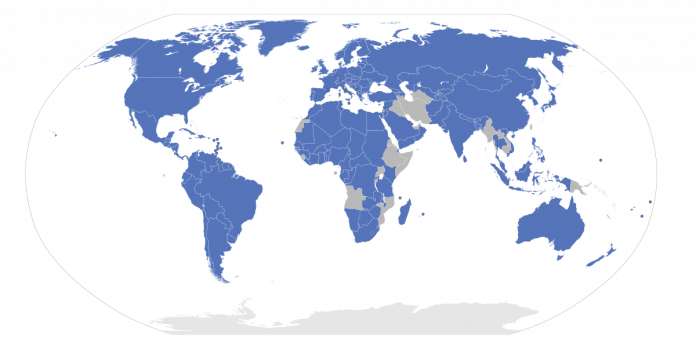This article is written by Divyanshi Singh of Symbiosis Law School, Noida. This article explains the UNCAT and why it should be ratified by the government.
Table of Contents
Introduction
It is so easy for the privileged individuals to sit in their blanket and say that ‘Yes, human rights are basic rights available to everyone!’ Hardly do they know the reality. Hundreds of people die in custodial violence each year. Custodial violence is nothing but exploitation of one’s human rights.
In 2020, the Supreme Court requested the government’s response to Section 176(1A) of the CrPc, which requires mandatory judicial inquiries into incidences of deaths, disappearances, rape, and other abuses in judicial custody after the death of father-son duo, Jayaraj and Bennicks. Let us understand the intricacies of custodial violence and how it infringes on one’s human rights.
What is UNCAT
The UNCAT or the United Nations Convention Against Torture is an international human rights treaty that was adopted in 1984 and is currently under revision by the UN. All United Nations member states have promised to fulfil the Universal Declaration of Human Rights’ commitment that “no one shall be subjected to torture or cruel, inhuman, or degrading treatment or punishment” (Article 5).
To fulfil this shared promise, the United Nations Convention Against Torture (UNCAT) of 1984 provided States with precise rules that specify the key features of effective torture prohibition and prevention.
The aims of this convention are as follows:
- To prohibit torture and other cruel, humiliating, or degrading treatment and punishment around the world.
- To prevent torture in any region under their jurisdiction, the Convention requires nations to take appropriate measures.
- It also prohibits governments from transporting people to any country where there is cause to believe they will be tortured.
- This convention’s absolute ban on torture and other cruel, inhuman, or humiliating actions has been a principle of customary international law since the convention entered into force.
Article 5 of the Universal Declaration of Human Rights states that “No one shall be subjected to torture or cruel, inhuman or degrading treatment or punishment.”
The Convention against Torture and Other Cruel, Inhuman or Degrading Treatment or Punishment was adopted by the UN General Assembly in December 1984. It defined custodial violence as any sort of violence that includes all such violence that is done by the state machinery.
One of the goals for the convention’s adoption was to counter the increased incidence of torture by public authorities, both during the war and in peacetime, and to persuade member governments to take appropriate preventive measures.
Torture is widely criticised across the globe. Aside from the Universal Declaration of Human Rights, it has been extensively incorporated into a wide range of international and regional human rights treaties, including-
- Article 7 of the International Covenant on Civil and Political Rights (ICCPR) (1966)
- Convention against Torture and Other Cruel, Inhuman or Degrading Treatment or Punishment (1984)
- The European Convention for the Protection of Human Rights and Fundamental Freedoms (1953)
- African Charter on Human and Peoples’ Rights (1979)
- American Convention on Human Rights (1969)
Custodial violence and torture
What is custodial violence and torture
Custodial violence is most commonly associated with violence under police and court custody. It encompasses murder, rape, and torture. Custodial violence is defined as violence that occurs in court and police custody when an accused is tortured emotionally or physically. The majority of the custodial deaths were linked to causes other than custodial torture, such as suicide and death in hospitals while receiving treatment. One of the most serious difficulties with imprisonment violence is that it jeopardizes human rights. This crime is an outburst against humanity and one of the numerous stumbling blocks in a democratic democracy.
Torture (from Latin tortus: to twist, torment) is the deliberate infliction of extreme bodily or psychological anguish on someone by another as a punishment or to fulfil the torturer’s wish or force the victim to perform some activity. Torturer’s goal is not just to cause severe trauma, but also to dismantle a person’s identity and humanity via physical or psychological anguish and suffering.
Torture is used by law enforcement officials as “questioning,” “sustained interrogations,” “extrajudicial executions,” and other terms. These activities by the police show a variety of tendencies to go overboard with such third-degree procedures. As per NCAT, torture methods used by the police included hammering iron nails into the body, applying roller on legs and burning, ‘falanga’ where the soles of the feet are beaten, stretching legs apart in the opposite side, hitting in private parts, stabbing with a Statutoryscrewdriver, electric shock, and so on.
Types of custodial violence
There are mainly 3 types of custodial violence:
- Physical violence: Using physical force or smashing, which may result in weariness and the dread of death
- Psychological violence: Mentally tormenting them on failing to provide accurate information. This can be accomplished through shame and threats as well.
- Sexual violence: This can involve verbal and sexual abuse, as well as humiliation of the victim’s dignity. This could have long-term psychological consequences for the victim.
Legal provisions for custodial violence in India
In 1984, the Law Commission of India proposed that if a man suffers bodily damage or death while in police custody, the court may conclude that the injury was caused by the police officer who had custody of that person at the time. For some reason, even this has not been followed up on 36 years later. The cops have been allowed carte blanche (complete freedom) because no proper anti-torture legislation has been enacted.
For decades, custodial violence has been a major human rights concern in India. It is one of the primary challenges to democracy and the advancement of human well-being. According to National Crime Records Bureau (NCRB) data, just 26 police officers were convicted of custodial violence between 2001 and 2018, despite 1,727 such deaths being registered in India.
To counter the tendency of police officers to use torture to extract confessions, etc., the Constitution of India as well as other statutory provisions were enacted which is discussed below.
Significant constitutional provisions that protect against custodial violence:
Article 20
- Right not to be a witness against himself: Article 20(3) of the Constitution states that no accused person can be forced to be a witness against himself. This right prohibits the act of coercion and torture by the police to get evidence. On the contrary, under Section 179 of the IPC, everyone is legally obliged to tell the truth to a public official about any subject. Section 161 of the CrPC also allows the police to question the accused during an inquiry. On the other hand, if the authorities apply any pressure, subtle or crude, mental or physical, direct or indirect, but considerable, to obtain information from an accused, it becomes ‘compelled testimony,’ a legal term.
Article 21
- Article 21 states that no one shall be deprived of life or personal liberty except following the procedure established by law. The right provides a constitutional guarantee against torture, assault, or harm, and thus serves as a deterrent to custodial torture and violence.
- The Supreme Court broadened the ambit of Article 21 of the Constitution in Maneka Gandhi vs. Union of India (1978), emphasising that this right is not limited to physical existence but also includes the fundamental right to live with dignity.
- In another case, Inderjeet v. State of Uttar Pradesh (2014), the Supreme Court ruled that torture-like punishment is unconstitutional.
- The Supreme Court ruled against mandatory handcuffing of inmates in Prem Shankar Shukla v. Delhi Administration (1980), ruling the practice to be inhuman.
Article 22
- Right to be informed of the ground of arrest: Article 22(1) of the Indian Constitution guarantees the arrested person the right to receive information about the reasons for his arrest, as well as the right to consult with a legal practitioner of his choice to defend him. Section 50 of the CrPC grants the accused person a similar privilege, as well as the right to request bail.
- The arrested person has the right to a speedy trial under Article 22(2) of the Indian Constitution. Any arrested person must appear before the nearest magistrate within twenty-four hours of being apprehended. Any additional detention requires the approval of a magistrate. Thus, he has the right to seek bail, to reveal his grievances arising from any maltreatment meted out to him in custody, and to have an impartial investigation on the validity of his arrest.
Other legal provisions:
- Section 41 of the Criminal Procedure Code (CrPC) was amended in 2009 to include safeguards under 41A, 41B, 41C, and 41D, ensuring that arrests and detentions for interrogation have reasonable grounds and documented procedures, arrests are made transparent to family, friends, and the public, and legal representation is available.
- Section 163 of the CrPC restricts investigating officers from any sort of bribing, intimidating or promising under Section 24 of the Indian Evidence Act (1872) and it also prohibits him from forcing someone to make any statement that he wishes to make of his own free choice. All confessions made through inducement, intimidation, or promise are inadmissible under Section 24 of the Indian Evidence Act of 1872. The clause gives the accused the right not to make any confession against his will because it is generally understood that if such evidence is declared admissible, it will provoke the police to employ torture and force to extract evidence against him.
- Section 348 of the IPC addresses wrongful confinement and prohibits such confinement to extort any confession or information to detect any offence or misbehaviour. Wrongful confinement has been made a penal offence, punishable by imprisonment for up to three years and a fine.
- Section 25 of the Indian Evidence Act provides that no confession given to a police officer can be used to convict him of any crime.
- Section 26 of the Indian Evidence Act declares that any confessions made while in custody are inadmissible unless made in the immediate presence of a Magistrate.
- Section 27 of the Indian Evidence Act provides an exemption to Section 25. It states that a statement made in custody may be acceptable if it leads to the discovery of some new information. However, the Supreme Court has stated that if the accused is forced to deliver a confession under this Section, he may exercise his protection against self-incrimination under Article 20(3) of the Constitution.
- Section 49 of the CrPC serves as a protection from excessive punishment. It specifies that an arrested individual can not be subjected to greater restriction than is necessary to keep him from escaping.
- As per Section 55A of the CrPC, the custodian of the accused person is duty-bound to take care of the accused’s health and safety.
DK Basu guidelines
In the case of DK Basu v. State of West Bengal (1996), the Court issued a list of 11 guidelines that police must follow in all cases of arrest and detention. In addition to the Constitutional and Statutory Safeguards, the guidelines are to be observed in all circumstances of arrest and detention. The following are the guidelines: –
- The police officers who conduct the arrest and interrogation of the arrested individual must wear accurate, visible, and legible identity and name tags with their designations. All workers who handle the arrestee’s interrogation must have their information entered in a register.
- The police officer carrying out the arrest should prepare an arrest memo at the moment of arrest, and that such memo shall be attested by at least one witness, who may be a member of the arrestee’s family or a respected person from the region where the arrest is made. It must also be countersigned by the arrestee and include the time and date of the arrest.
- A person who has been arrested or detained has the right to have one friend, relative, or other person known to him told that he has been arrested and is being detained at the specific location unless the attesting witness of the arrest memo is himself such a friend or relative of the arrestee.
- The time, place of arrest, and venue of custody of an arrestee must be telegraphically communicated by the police to the next friend or relative of the arrestee who lives outside the district or town via the Legal Aids Organization in the District and the police station of the area concerned within 8 to 12 hours of the arrest.
- As soon as he is arrested or detained, the arrested person must be informed of his right to have someone informed of his arrest or detention.
- At the place of detention, an entry must be made in the diary regarding the arrest of the person, which must also reveal the name of the next friend of the person who has been informed of the arrest, as well as the names and contact information of the police officials in whose custody the arrestee is.
- During the arrest, the arrestee must be examined for any major and minor injuries. If there is an injury on the body, it must be recorded at that moment. The Inspector Memo must be signed by both the arrestee and the officer making the arrest, and a copy must be handed to the arrestee.
- During his custody, the arrestee shall be subjected to a medical examination by a trained doctor every 48 hours.
- Copies of all documents, including the arrest memo mentioned above, should be given to the Magistrate for his records.
- The arrestee may be allowed to meet with his counsel during interrogation, but not for the duration of the interrogation.
- A police control room should be provided at all district and State headquarters where information about the arrest and the arrestee’s place of custody should be communicated by the officer causing the arrest within 12 hours of the arrest and displayed on a conspicuous notice board.
Steps taken by India to implement UNCAT
In 2010, Lok Sabha had passed the Prevention of Torture Bill, 2010 as a hesitant step to ratify UNCAT. Following this, a Rajya Sabha multi-party select committee was set up to improve the Bill under the chairmanship of Advocate Ashwini Kumar. However, the Bill lapsed.
According to a recent report by the National Campaign against torture, 1,731 persons died in police custody in India in 2019. That equates to the death of about five people per day.
In an interview with The Wire, Ashwini Kumar emphasised that before ratifying a treaty, India’s conventional practice is to first pass national legislation expressing any international treaty obligation. This means that before ratifying the UNCAT, India will need to implement a Prevention of Torture Bill. Consequently, such a Bill was suggested by the Law Commission, the National Human Rights Commission, and the Rajya Sabha Select Committee but has not been paid much heed to.
In 2016, Ashwini Kumar had approached the Supreme Court to seek direction from the government for ratification of the convention, however, the petition was turned down after being pending for 3 years.
In 2017, the Law Commission of India recommended that the government should ratify the UN Convention Against Torture and draft an anti-torture law. The Law Commission also proposed a draft for the same, however, the proposed Bill lacked essential requirements for a stable law.
National Human Rights Commission
On October 12, 1993, National Human Rights Commission (NHRC) was founded. The 1993 Protection of Human Rights Act (PHRA) was revised in 2006 and again in 2019.
The Commission embodies India’s concern for the creation and protection of human rights. Recognizing that custodial torture is one of the most serious violations of human rights, the Commission gave comprehensive instructions to law enforcement officials on how to report deaths in police cells and penal facilities soon after its formation. It required the DMs and SPs of the districts to report custodial deaths within 24 hours of the death. The recording of post-mortem examinations has now been made mandatory.
There is no doubt that the NHRC’s proactive involvement has put some pressure on the police, as there is always the risk that they will be held up at any point. The Commission does not solely rely on police records, and it places a high value on complaints received from the victim’s family members. According to a Transparency International report, the commission received more than 16 lakh allegations of custody fatalities from 1993 to 2016, with just about 22,000 still for resolution. Furthermore, the procedure of filming, post-mortem examination, and judicial inquiry has made the process more public and has prompted law enforcement officials to be more cautious.
Why should India ratify the UNCAT treaty
India signed the treaty in 1997, however, it is one of the few countries that have yet to do so. According to the National Human Rights Commission, violence and torture in prisons and jails are already “rampant.” According to the National Human Rights Commission (NHRC), 1,731 persons died in detention in 2019. And these are only the reported cases.
‘Dalit Lives Matter’ and other trends akin to the US’s ‘Black Lives Matter’ has failed to address the root cause of police torture in both democracies. The distinction is critical. The dominating issue in America has quickly shifted to ‘racism’ (whose corrections are, quite rightly, inclusive measures such as seeking greater Black presence in more diverse areas of employment and education). Unfortunately, just naming a social issue such as “racism” or “casteism” does not address the criminal in the room, the police officer, whose aggression is sanctioned by the state. Both social and criminal issues must be addressed in diverse ways in India, the United States, and everywhere.
During the same week that the world observed International Day in Support of Victims of Torture (June 26) in 2020, a father-son duo in Tamil Nadu who kept a shop open after the COVID-19 curfew hours perished in custody, allegedly after being tortured by the Thoothukudi district police. The persistence of brutal treatment demonstrates that India is willing to safeguard police violence. India is one of only a few countries that have yet to ratify the United Nations Convention Against Torture and Other Cruel, Inhuman, or Degrading Treatment or Punishment, which was adopted in 1987. (UNCAT).
Torture can never be justified under any given circumstances. War, insurgency, public emergency, or orders from superiors cannot be used to justify the practice. It is expressly prohibited by our Constitution, our laws, and our Supreme Court’s categorical pronouncements. It is categorically illegal, both under international humanitarian law and the United Nations’ human rights standards. Nonetheless, the National Human Rights Commission receives petitions daily alleging the use of torture, as well as deaths in prison, as a result of the actions of those sworn to preserve our Republic’s laws and Constitution, as well as to ensure the security of its residents.
Every death in custody serves as a reminder of why India should ratify the Convention Against Torture.
Conclusion
A new norm of connection between the state and the people is required, as said by Anne Gallagher, director-general of the Commonwealth Foundation, in 2020. How can millions of citizens expect humanitarian protection against forced migration, exploitation, and bondage when the Government of India is hesitant to approve fundamental legislation to protect them from everyday violence perpetrated by its agencies? The UNCAT may not be the sole solution, but it is unquestionably a component of it. And we can use it to find a solution.
References
- https://www.civilsdaily.com/news/united-nations-convention-against-torture-uncat/
- https://nhrc.nic.in/
- https://www.unicef.org/child-rights-convention/what-are-human-rights
- https://www.amnesty.org/en/countries/asia-and-the-pacific/india/report-india/
- https://byjus.com/free-ias-prep/custodial-violence/
- https://www.ohchr.org/EN/AboutUs/Pages/WhoWeAre.aspx
- https://www.academia.edu/4664033/HUMAN_RIGHTS_IN_INDIA_ITS_PRESENT_STATUS_POSITIONS_CASES_OF_VIOLATIONS_AND_SOME_REMEDIAL_MEASURES
- https://thewire.in/rights/custodial-deaths-india-convention-against-torture
- https://www.indiacode.nic.in/bitstream/123456789/11184/1/the_protection_of_humen_rights_act_1993.pdf
- https://www.google.com/url?q=https://nhrc.nic.in/press-release/government-urged-ratify-un-convention-against-torture&sa=D&source=editors&ust=1630434162452000&usg=AOvVaw1YLoKNN4PzuXKt6Iwk3E8C
- https://www.google.com/url?q=https://nhrc.nic.in/press-release/government-urged-ratify-un-convention-against-torture&sa=D&source=editors&ust=1630434162452000&usg=AOvVaw1YLoKNN4PzuXKt6Iwk3E8C
- https://www.google.com/url?q=https://thewire.in/rights/custodial-deaths-india-convention-against-torture&sa=D&source=editors&ust=1630434162454000&usg=AOvVaw0OvJvJUy6S4KnNBo3AEhkl
- https://www.google.com/url?q=https://thewire.in/rights/watch-indias-23-year-old-failure-to-ratify-un-convention-against-torture-is-shameful&sa=D&source=editors&ust=1630434162460000&usg=AOvVaw3RdlFo-O62L-xqjj5VP9vH
- https://www.google.com/url?q=https://www.omct.org/en/resources/statements/india-time-to-put-promises-into-action-a-call-for-ratification-of-un-torture-convention-and-the-adoption-of-a-strong-anti-torture-law&sa=D&source=editors&ust=1630434162464000&usg=AOvVaw0jIIBXFZFjeev-9maeKG_b
- https://www.google.com/url?q=https://www.researchgate.net/publication/333651436_What_prevents_India_from_ratifying_Convention_against_Torture_CAT&sa=D&source=editors&ust=1630434162467000&usg=AOvVaw3BtHIZOO3_RMZd6nuHZuiL
Students of Lawsikho courses regularly produce writing assignments and work on practical exercises as a part of their coursework and develop themselves in real-life practical skills.
LawSikho has created a telegram group for exchanging legal knowledge, referrals, and various opportunities. You can click on this link and join:https://t.me/joinchat/J_0YrBa4IBSHdpuTfQO_sA
Follow us on Instagram and subscribe to our YouTube channel for more amazing legal content.
 Serato DJ Crack 2025Serato DJ PRO Crack
Serato DJ Crack 2025Serato DJ PRO Crack











 Allow notifications
Allow notifications



